Portugal is the practical example of the expression “size does not matter”. Despite its small size, it holds an important secular heritage in art, education and literature. Land of Camões, Saramago and Fernando Pessoa, the “terrinha”, as it is affectionately known, owns a very rich gastronomy and full of good ingredients.
Famous for the production of wines, olive oil and olives, the nation practices a typical Mediterranean diet, based on fish, seafood and vegetables. Therefore, it will be difficult to find restaurants that mix carbohydrates. On the other hand, it is impossible not to enjoy the immense variety of starters, soups and desserts.
see more
Astrology and genius: THESE are the 4 most brilliant signs of…
iPhones that didn't succeed: 5 launches rejected by the public!
Result of Atlantic and Mediterranean influences, thanks to the pioneering spirit of the country in the Great Navegações, Portuguese cuisine has a notable regional variety, despite being a country small. The typical dishes of each region reflect the landscape, cultural heritage and available resources.
The typical Portuguese cuisine has dishes that differ according to the region, even in view of the small territorial extension of the country. However, some ingredients are common in most recipes, such as olives, olive oil, bread and wine. Territorial conquests overseas soon incorporated other ingredients, such as spices, sugar, beans and potatoes.
Other very common elements in Portuguese dishes are cod, prepared in “a thousand and one ways”, meat (beef, pork and lamb), ham, viscera, as well as soups and seafood. As we will see, eggs and sugar are the basis of most sweets, most of them a religious heritage.
The use of eggs even comes from the tradition of nuns who lived in the Middle Ages. They used egg whites to starch their caps and, avoiding wasting what was left, made sweets with the egg yolks.
Brazilians are among the tourists who visit Portugal the most and are also more satisfied with Portuguese cuisine. However, it is interesting to point out some differences between the dishes of the two countries. The first of them is in the sausage. Over there, the closest thing to pepperoni that we know is chorizo.
It is a pork meat and blood sausage seasoned with salt, garlic, peppers, white wine. Another specimen that is very popular with the Portuguese is the alheira, with Alheira de Mirandela being the best known. The sausage of Jewish origin has poultry meat, bread, olive oil and special seasonings.
The ham, as we know it around here, is called ham in the “terrinha”. Its production is almost artisanal and the result has a flavor and appearance a little different from those we find around here. Oh, and when asking for “smoked” meat, replace the term with “smoked”, as the modality is called in Portugal.
The Seven Wonders of Portuguese Gastronomy were the result of a promotion of the country's historical and cultural heritage. Voting was done by the public, reflecting the traditional gastronomy, the riches of each region and, of course, the members of the country's good food. The criteria established to enter the dispute were:
And, those who met all these requirements and were elected by the people are:
Sardine

That simple! The sardine is one of the most consumed fish in Portugal and is present in religious festivals, such as those celebrated for São João and Santo Antônio. In fact, the sardine is one of the symbols of Portuguese culture and appears in the main dishes of the country. It is usually prepared on the grill and served with boiled potatoes and green peppers.
Cod

There's no way to talk about Portuguese cuisine without mentioning cod! Fish is so traditional in Portugal that it can be found in an immense variety. And the explanation for consumption is the price, much lower than beef. For this reason, practically all houses have cod on the table, either as a starter or as a main course.

Fried, roasted, in the form of a dumpling (which is called pastel there) and even raw, in the so-called “cod jerks”, a kind of ceviche (fish, onion, garlic, parsley and olive oil). The names of the recipes are many, so be prepared to read “Gomes de Sá” on the menus, with bread, à brás… In the first one, it is baked with cream and potatoes. A delight!
Rice
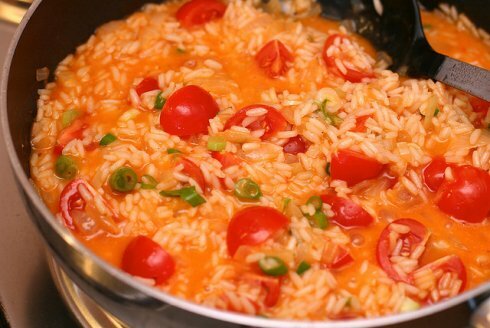
Rice is quite present in Portuguese cuisine, often as a typical accompaniment to most dishes. However, it is served in the most varied forms.
Tomato rice is cereal cooked with sauce and seasoning. It is usually served with meat and fish. Bean rice mixes the two and, of course, a lot of seasoning.

Duck rice, in turn, is a kind of risotto made with oven-roasted duck meat. The dish is served with chorizo on top. Seafood rice, born in the Vieira region, includes clams, shrimp, mussels and other seafood. Their combination will depend on where the dish is prepared.

Green soup
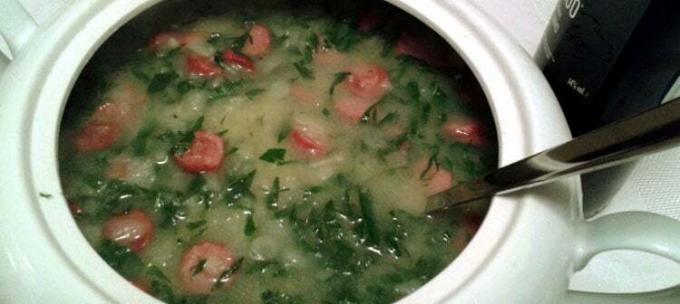
A dish that has already crossed the Atlantic and ended up in Brazil, the green broth is made with olive oil, potatoes, paio, sausage, water and cabbage. Simple and tasty!
Feijoada

For everything! What do you mean, feijoada? Yes, friends, “our” feijoada has European origins with strong indications of its preparation in Portugal. Over there, the most famous are Feijoada Portuguesa and Feijoada Transmontana, made with white and red beans, respectively. In addition to pork, they carry seafood and rabbit meat.

Portuguese stew
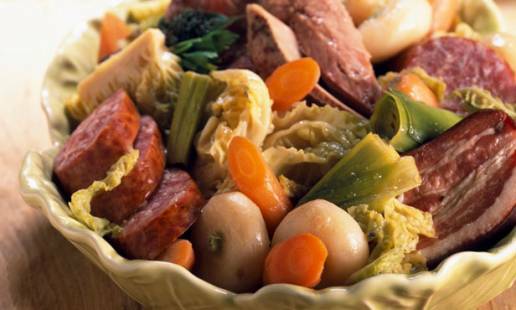
A very traditional dish in the country, the Portuguese stew is one of those that sustain you for almost a day! The recipe calls for potatoes, beans, turnips, carrots, cabbage, meat (preferably all), black pudding (a type of chorizo) and chorizo (stuffed with meat, fat and pork blood).
Bairrada roast suckling pig

You noticed that the Portuguese love pork, right? Bairrada roast suckling pig was born in the region of the same name and was mentioned in a document dated 1743.
Francesinha

It's that dish that tourists try and want to repeat every day! The francesinha is a Portuguese food created in the Porto region and it is in the north of Portugal that it is best prepared. The dish is made with bread, chorizo, steak, bacon, ham, cheese, egg and Port wine sauce, as well as tomato and pepper. Served with french fries.
Açorda de Mariscos

The dish is based on seafood, with cockles, shrimp, molluscs, fish broth, bread, eggs and seasonings.
Alheira

Do you know the sausage? So, alheira is something like that, stuffed with game, poultry or beef. The dish was invented by Jews fleeing the Inquisition. You can find it smoked, fried or baked, as well as options wrapped in a kind of puff pastry.
Alentejo style pork

A typical dish from the Alentejo region, it combines clams and fried pork cut into cubes.
cornbread
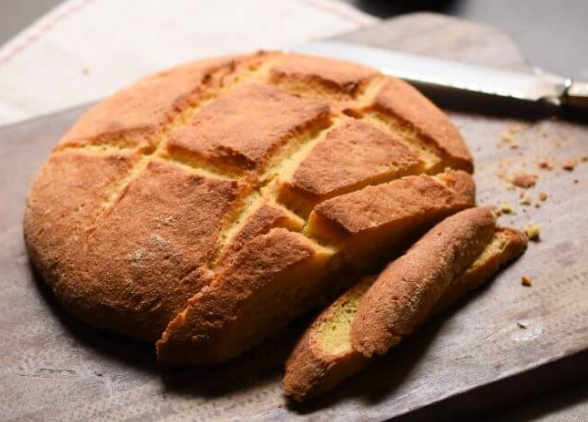
Forget the typical bread from our kitchen, because although both are delicious, the recipes are very different. Portuguese broa is made with corn and rye bread, usually served as a starter for meals or grated over fish.
Cheese
Ah, the cheeses of Portugal! As popular as cod, wine and pasteizinhos de Belém, cheeses came to show the world why we should go on a diet before traveling to the country! Serra da Estrela cheese is one of the most symbolic. Considered one of the 7 Wonders of Gastronomy in Portugal, it is the oldest in the country.

This cultural heritage is made with goat cheese and its maturation process takes more than 30 days. The result is a very creamy piece inside and surrounded by a cone. Azeitão cheese is traditional from the region of the same name, in the district of Setúbal. Made with sheep's milk, it has a protected designation of origin.

Pastel de Nata
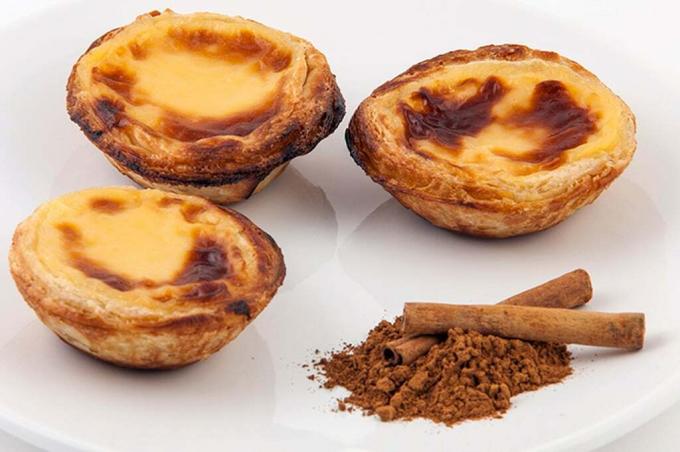
The pastel de nata is the Pastel de Belém that we know in Brazil. But, attention! We only find the pasteizinhos de Belém in the region of the same name, in Lisbon, the Portuguese capital. The recipe, by the way, was born in this place and takes tourists to kilometers long queues to try it. The others are the traditional custard tarts, always very tasty.
Pudding Priscos De Abade

Many Portuguese sweets find their origin in religious temples. This one, for example, was born when the director of the Primary Teaching for Women in Braga, at the Convento dos Congregados, asked the Abbot of Priscos to teach the school recipes. From there, a pudding made with bacon, wine, cinnamon, caramel and lemon came out.
Algarve Almond Tart

Portuguese sweets are the kind you eat on your knees! This recipe features caramelized almonds whose preparation leaves it with a crunchy consistency.
Santa Clara Pastel

Another sweet with religious origins, this time, born in the Convent of Santa Clara, in the city of Coimbra.